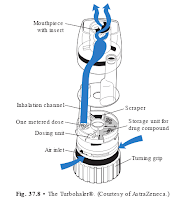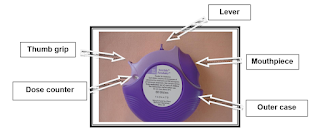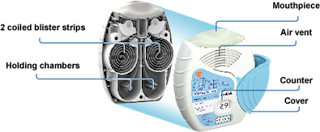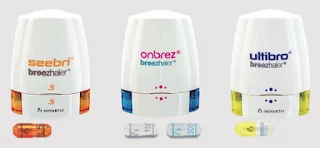Dry-Powder Inhalers (DPIs)
Introduction
Dry-powder inhalers are portable, inspiratory-flow-driven inhalers that administer dry-powder formulations to the lungs.
- DPIs do not contain propellant and are breath-actuated, hence eliminating the need of hand-held coordination of conventional MDIs.
- Nonetheless, the patient's inspiratory flow should be adequate enough to draw the drug from the device.
- Importantly, the air vents on each DPI should not be covered to ensure smooth airflow.
- Also, all DPIs must be protected from humidity and moisture to prevent powder clumping, which can include moisture from exhaled air entering the mouthpiece. Therefore, patients should be instructed to exhale away from the DPI prior to and after inhalation.
NOTE: DPIs are not suitable for children ≤5 years and some elderly. Capsule devices are difficult for patients with tremor.
Turbuhaler
Turbuhaler contains a large number of doses (up to 200) of undiluted, loosely aggregated micronized drug, which is stored in a reservoir from which it flows on to a rotating disc in the dosing unit.
- As the rotating disc is turned, by moving a turning grip back and forth (a "click" sound is heard in one of the turning direction), one metered dose is presented to the inhalation channel.
- Perform this procedure twice for priming.
- If the Turbuhaler is accidentally dropped, a new dose should be loaded and inhaled.
Inhale the medication.
- Breathe out fully and away from the mouthpiece.
- Place the mouthpiece gently between the lips (ensure tight seal around it). Then breathe in forcefully and deeply through the mouth.
- Holding breath after inhalation is optional.
- Remove the Turbuhaler from mouth and then breathe out away from the Turbuhaler.
Turbuhaler makes no sound when the drug is released. Moreover, since the amount of drug delivered by Turbuhaler is small, there is either no or only a faint taste in the mouth when the drug is delivered. This can, in some cases, lead to patients being uncertain as to whether they have received the required dose.
- The correct functionality of the Turbuhaler can easily be checked by inhaling through a piece of dark cloth.
Clean up the Turbuhaler.
- At least once a week or whenever necessary.
- Wipe the outside of the mouthpiece, using dry cloth only.
For Pulmicort and Symbicort, when a red mark can first be seen in the indicator window, there are approximately 20 doses left.
- Once the red mark reach bottom of the indicator window, there is no more medicine left.
- The sound upon shaking the Turbuhaler is produced by a drying agent, not the medication.
Accuhaler (Diskus)
Accuhaler is a moulded plastic inhaler device containing a foil strip with 60 blisters.
Hold the outer case in one hand and put the thumb of the other hand on the thumb grip to open the Accuhaler.
- Push the thumb grip as far as it will go until a "Click" sound is heard. The mouthpiece should now be fully visible.
- Hold the device horizontally with the mouthpiece towards the patient.
- Slide the level as far it goes as in diagram until another "Click" sound is heard to load a dose in the device.
- Never hold the inhaler with the mouthpiece pointing downwards during or after loading a dose, as the medication can be dislodged.
Inhale the medication.
- Hold the Accuhaler away from mouth and breathe out completely.
- Put the mouthpiece into mouth and ensure a good seal. Do not chew or bite on the mouthpiece.
- Breathe in forcefully and deeply through the mouth only.
- Remove the Accuhaler from the mouth and hold breath for 10 seconds or as long as possible.
- Close the device by sliding the thumb grip back to its original position until a "Click" sound is heard.
Maintenance
- Wipe the mouthpiece of the Accuhaler with a dry cloth or tissue at least once a week or whenever necessary.
Easyhaler
Easyhaler has been designed to resemble a MDI in terms of the small size of the device, but importantly avoids the need to coordinate drug release and inhalation.
Preparing the powder inhaler for first use.
- Remove the powder inhaler from the laminated pouch.
- Insert the powder inhaler into the protective cover. The dust cap on the mouthpiece prevents accidental actuation of the inhaler when inserting it into the protective cover.
Delivering the medication
- Remove the dust cap.
- Shake the device 3-5 times (1 shake = up and down) prior to each dose to allow proper powder flow and a correct dose. After shaking, hold the device in the upright position.
- Press the device only once between the thumb and forefinger until a "CLICK" sound is heard. Release the inhaler to return to the original position. Keep holding the device in the upright position.
- Breathe out normally, away from the mouthpiece.
- Place the mouthpiece between lips and close tightly around the mouthpiece. Do not chew or bite on the mouthpiece.
- Breathe in forcefully and deeply through the mouth only.
- Remove the Easyhaler from mouth and hold breath for 5-10 seconds, and then breathe out away from the Easyhaler.
- Repeat the steps above if more than one dose is required.
- Put the dust cap back on the mouthpiece.
Maintenance
- The mouthpiece can be cleaned with a dry cloth or tissue.
- Never use water or any other fluid when cleaning the mouthpiece.
- After the laminate pouch has been opened, Buventol, Giona and Beclomet Easyhalers can be kept for 6 months.
Ellipta
The package should only be opened when you are ready to begin using your inhaler.
- Once you tear open the foil, you should use your Ellipta inhaler within 6 weeks.
NOTE: Do not shake the inhaler, block the air vents with your fingers or breathe out into the inhaler.
Maintenance
- Clean the mouthpiece immediately after inhalation with a dry cloth/tissue, before sliding back the cover.
HandiHaler
HandiHaler is a device used to deliver tiotropium bromide (Spiriva) into the lung, but now replaced with Respimat.
- Tiotropium bromide (Spiriva) comes in light green, hard gelatine capsule-containing powder form and contains 18 mcg tiotropium blended with lactose monohydrate as a carrier.
- Spiriva capsules should not be swallowed and must be used with HandiHaler device only.
Preparing the medication.
- Open the dust cap by pressing the green piercing button.
- Pull the dust cap upwards to expose the mouthpiece.
- Open the mouthpiece by pulling it upwards.
- Carefully remove the capsule from the blister pack and place the capsule in the center of the chamber.
- Close the mouthpiece firmly until a "CLICK" sound is heard.
- Hold the HandiHaler device with the mouthpiece pointed upright and press the green piercing button completely to make holes in the capsule.
Inhaling the medication.
- Breathe out completely and away from the mouthpiece.
- Place the HandiHaler horizontally to the mouth and close the lips tightly around the mouthpiece, without blocking the air intake vents.
- Breathe in slowly and deeply at a rate sufficient to hear the capsule vibrates.
- Remove the device from the mouth and hold breath for 5-10 seconds or as long as possible, then resume normal breathing.
- To ensure that all the medicine is inhaled, repeat the steps above to breathe in again from the same capsule.
- Open the mouthpiece and dispose the empty capsule immediately
- Close the mouthpiece and dust cap for storage.
- Always use the new HandiHaler provided with your medicine and clean your device as needed.
- Look in the center chamber for capsule pieces or powder buildup. If seen, tap out.
- Open the dust cap, mouthpiece and chamber.
- Rinses all parts with warm water to remove any powder. Do not use cleaning agents or detergents.
- Pressing the green piercing button a few times so that the center chamber and the piercing needle is under the running water.
- Dry the HandiHaler thoroughly by shaking off the excess water and air-drying it afterwards, leaving the dust cap, mouthpiece and base open.
- It takes 24 hours to air dry, so clean it immediately after use.
- Do not use the HandiHaler when it is wet.
- If needed, the outside of the mouthpiece may be cleaned with a moist, but not wet, tissue.
NOTE: The piercing of the Spiriva capsule may produce small gelatin pieces and may pass into your mouth or throat during inhalation. This is normal and is not harmful.
Breezhaler
The Breezhaler is a breath-activated device.
Prepare capsule.
- Immediately before use, with dry hands, remove one capsule from the blister.
- Place the capsule into the capsule chamber.
- Close the inhaler until you hear a "click".
- With the mouthpiece pointing up, pierce the capsule by firmly pressing together both side buttons at the same time. Do this only once.
- Release the side buttons fully.
Inhale the medication.
- Before placing the mouthpiece in your mouth, breathe out fully and away from the mouthpiece.
- Breathe in rapidly but steadily and as deeply as you can.
- As you breathe in through the inhaler, the capsule spins around in the chamber and you should hear a whirring noise. You will experience a sweet flavour as the medicine goes into your lungs.
- Occasionally, very small pieces of the capsule can get past the screen and enter your mouth. If this happens, you may be able to feel these pieces on your tongue. It is not harmful if these pieces are swallowed or inhaled. The chances of the capsule shattering will be increased if the capsule is accidentally pierced more than once.
- After you inhaled the medicine, hold your breath for at least 5-10 seconds or as long as you comfortably can while taking the inhaler out of your mouth.
- Then breathe out, away from the mouthpiece.
- Open the inhaler to see if any powder is left in the capsule. If there is powder left in the capsule, close the inhaler and repeat the steps above.
- After you have finished taking your medicine, open the mouthpiece again, remove the empty capsule by tipping it out of the capsule chamber. Put the empty capsule in your household waste. Close the inhaler and replace the cap.
Maintenance.
- Wipe the mouthpiece inside and outside with a clean, dry, lint-free cloth to remove any powder residue.
- Keep the inhaler dry. Never wash your inhaler with water.
- Each inhaler should be disposed of after all capsules have been used.
Summary
Unlike metered-dose inhalers, dry powder inhalers require a stronger minimum inspiratory force for optimal effectiveness.
- Importantly, each type of DPI has a different intrinsic resistance to airflow, which determines the inspiratory force required to release the correct dose of medication.












Comments
Post a Comment